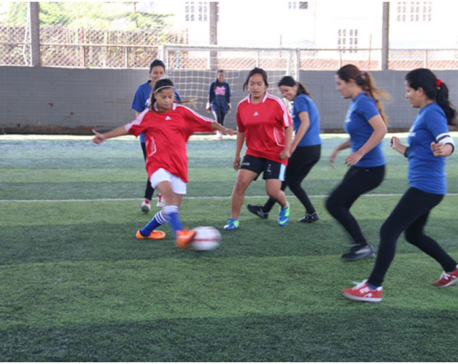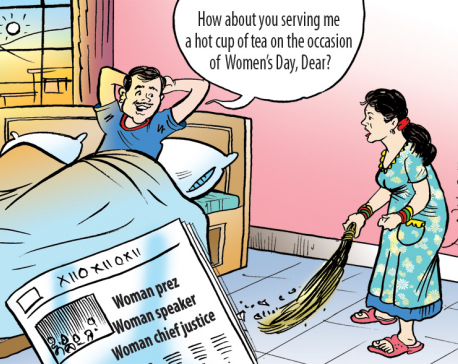
OR
Harassment in public transport
No safe zones for women
Published On: February 13, 2018 01:00 AM NPT By: Biranchi Poudyal/ Samikshya Thapa


Biranchi Poudyal/ Samikshya Thapa
Poudyal and Thapa are researchers at Global Initiative for Vivid Empowerment, a Kathmandu based NGOnews@myrepublica.com
More from Author
Chronic anxiety of sexual harassment in public transport narrows down socio-economic prospects of women
Sexual harassment on public transport remains a daily experience for millions of women residing in the cities. Harassment has become the matter of social debate but the bigger picture has not yet got proper attention in the discussion forum. When it comes to sexual harassment in public transportation, the issue of female sexual right, psychological trauma and women empowerment dominate the discourse. Such harassment experience not only makes women traumatic but also has a long-term effect on women’s access to socioeconomic opportunity and their mobility pattern. During our research in Kathmandu valley, we found many women who chose to abandon handsome paying evening shift jobs just because of safety concern in public vehicles. In this regard, a constant threat of harassment actually influences women’s potential to move freely in public and also impacts their decision to involve in the labor market or the kinds of career opportunities they pursue.
According to Global Mobility Report released in December 2017 “the lack of personal security, or the inability to use public transport without the fear of being victimized―whether on public transport, walking to or from a transit facility or stop, or waiting at a bus, transit stop, or station platform―can substantially decrease the attractiveness and thus the use of public transit.” Freedom of physical movement is essential in the growth of every individual’s social and economic horizon but the possible chronic anxiety of sexual harassment in transport can lead to disconnection with public spheres and narrow down the socio-economic prospect for many women.
Limiting potentials
In practical ground such mobility barrier limits the number of trips women make, resulting in a decline in household income, as unsafe transportation prevents women from accessing their full employment and academic opportunities. There are many families in Kathmandu that don’t allow female counterparts to take up outer economic employment due to lack of safe travel options. And even while choosing a college for their daughters some parents inside the valley give topmost priority to viable transportation over quality education. Ensuring safe transport mobility would open up better access to quality education and career opportunity for thousands of girls.
Moreover, vehicle insecurity is indirectly fostering traffic problem, as more privileged women who hesitate to use public vehicle turn to private vehicles, adding more density in already congested roads of Kathmandu.
When we see crowded public transport we may not directly link it with a gender perspective. But male and female’s experiences with public vehicle differ critically in regard to physical safety and security. Most public vehicles in Kathmandu comprise spaces like front-facing seats narrow passages where women remain vulnerable to sexual assaults. Ask any male about his topmost priority in public vehicle. Most likely he will answer ‘speed or comfort’. Ask the same question to any female and the answer will probably be ‘safety’. “My parents didn’t let me enroll in the college I chose because they didn’t have college bus. In public bus girls like me remain vulnerable to sexual assault,” said one of the college students from Kathmandu.
It sometimes seems like crowded public vehicles allow ill-intentioned males both anonymity and opportunity to involve in sexual abuse with minimum risk of legal or social penalties. The research entitled “Sexual Harassment in Public Vehicle of Kathmandu” conducted by our organization has found that despite the seriousness of such sexual assaults very few women report the case—statistically less than two out of ten. Women tend not to report the majority of such occurrences fearing that they will be accused of being over-reactive or not taken seriously.
Prevention measure
To respond to this problem, Kathmandu has experimented with “women only bus service” that literally puts women in a safe zone beyond physical reach of the potential assaulter. This is only immediate intervention to the problem. It doesn’t change the attitude of the assaulter. Solutions need to be sustainable. Proper utilization of technology could help. Today, we all have multi-functional phones in our pockets. We can click picture or record video of a harasser. Additionally empowering women to respond to harassment and giving them defensive training is essential.
Analyzing Nepal’s transport situation, as required by modern mobility paradigms and whole travel experiences, the increasing evidence of sexual assault in a vehicle can be seen as a policy failure and non-inclusive transport system. Our future transport management framework needs to consider multidimensional aspects of mobility and the factors influencing or restricting women’s travel choices. While designing transportation structures, the gender-specific study should be carried out. Transport policy must include gender indicators before allotting public vehicles. Good design of public vehicles could play a role in creating safe space for women and minimize probable circumstances of sexual assaults.
Poudyal and Thapa are researchers at Global Initiative for Vivid Empowerment, a
Kathmandu based NGO
You May Like This

Futsal for the women, by the women and of the women!
KATHMANDU, March 19: WE United Project launched the Mahila Premier League (MPL) on March 18 at Grassroots Recreational Center in Mandikhatar. ... Read More...

Leader Dahal urges women to be united for meaningful women participation
KATHMANDU, June 15: CPN-Maoist Centre Chairperson Pushpa Kamal Dahal has urged the women folks to be united for their meaningful... Read More...

Is women empowerment just women employment?
If this day is to celebrate your and my achievements, then it does not need to be marked in the... Read More...





Just In
- MoHP cautions docs working in govt hospitals not to work in private ones
- Over 400,000 tourists visited Mustang by road last year
- 19 hydropower projects to be showcased at investment summit
- Global oil and gold prices surge as Israel retaliates against Iran
- Sajha Yatayat cancels CEO appointment process for lack of candidates
- Govt padlocks Nepal Scouts’ property illegally occupied by NC lawmaker Deepak Khadka
- FWEAN meets with President Paudel to solicit support for women entrepreneurship
- Koshi provincial assembly passes resolution motion calling for special session by majority votes






_20220508065243.jpg)






Leave A Comment